 |
 |
 |
| |
Viral Suppression Among People Initiating HIV Care: Outcomes from iENGAGE Trial
|
| |
| |
Reported by Jules levin
CROI 2019 March 4-7 Seattle
KR Amico*, R Modi, AO Westfall, J Willig, JC Keruly, S Napravnik, HM Crane, EB Quinlivan, AL Zinski CE Golin, DM Long, RD Moore, M Saag, J Raper, MJ Mugavero for iENGAGE Study Team
RESULTS
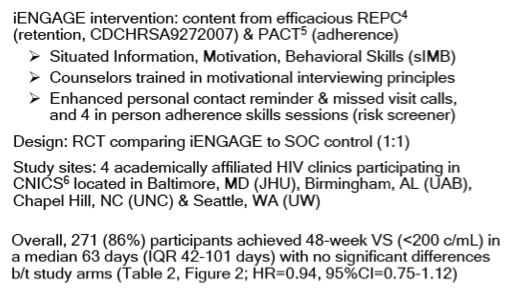
Reported by Jules levin
CROI 2019 March 4-7 Seattle
KR Amico*, R Modi, AO Westfall, J Willig, JC Keruly, S Napravnik, HM Crane, EB Quinlivan, AL Zinski CE Golin, DM Long, RD Moore, M Saag, J Raper, MJ Mugavero for iENGAGE Study Team
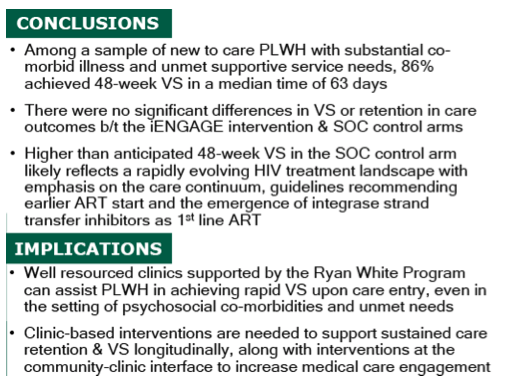
ABSTRACT
Background: Optimizing engagement in HIV care represents the greatest opportunity to maximize the individual and population health benefits of sustained viral suppression (VS; <200 c/mL). Among people living with HIV (PLWH) initiating outpatient HIV care, early missed clinic visits and suboptimal retention in care (RIC) result in failure to achieve and sustain VS, impacting personal health outcomes and onward HIV transmission.
Methods: The NIH-funded iENGAGE trial (NCT01900236) enrolled PLWH within 14 days of their initial outpatient HIV care visit at 4 CFAR-affiliated academic HIV clinics. Participants were randomized to an intervention or standard of care (SOC) control arm (1:1). The intervention integrated and adapted 2 evidence-based approaches with demonstrated efficacy for RIC and ART adherence; enhanced personal contact/reminders and a 4 session counseling program based on Motivational Interviewing and grounded in a situated information, motivation and behavioral skills (sIMB) framework. Participant baseline and 48-week computer assisted surveys were done using validated instruments. A sample size of 400, with 10% attrition, provided >80% power to detect a 15% difference in 48-week VS, with 60% VS estimated in the SOC arm based upon historical data.
Results: Between 12/13 and 06/16, 371 participants enrolled (62% black, 19% women, 24% uninsured, 60% MSM, 25% CD4<200). Baseline psychosocial co-morbidities included: 31% depression, 31% anxiety, 35% high-risk alcohol use, 18% active substance use. Roughly half the sample (49%) reported unmet need for supportive services (e.g. housing, employment, food and transportation). Overall, 86% of participants achieved 48-week VS; 86% intervention, 87% SOC; p=0.87. Median time to VS was 63 days (IQR 42-101) and did not differ between the two study arms (HR=0.94, 95%CI=0.75-1.19).
Conclusions: Among new to care iENGAGE participants with substantial co-morbid psychosocial illness and unmet need for supportive services, 86% achieved 48-week VS in a median time of 63 days with no differences between study arms. The similarity of results by study arm and the higher than expected VS rate in the SOC group likely reflects a rapidly evolving HIV treatment landscape, which emphasizes the care continuum, rapid ART initiation and the emergence of integrase inhibitors as first-line therapies. Sustaining care engagement and VS among new to care PLWH beyond the first year is imperative to maximize the individual and population health benefits afforded by modern HIV treatment.
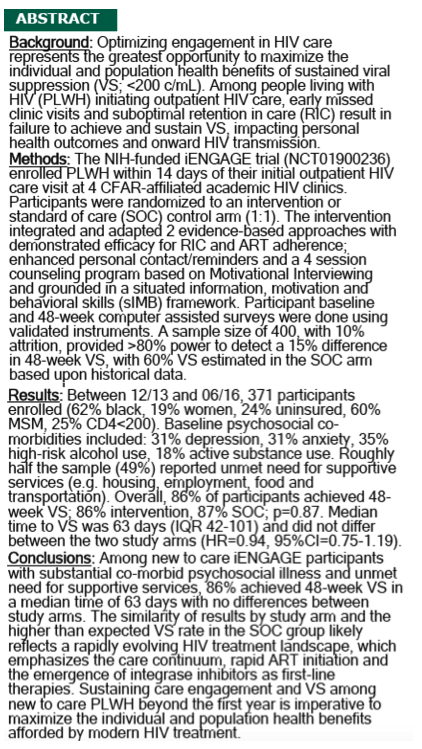
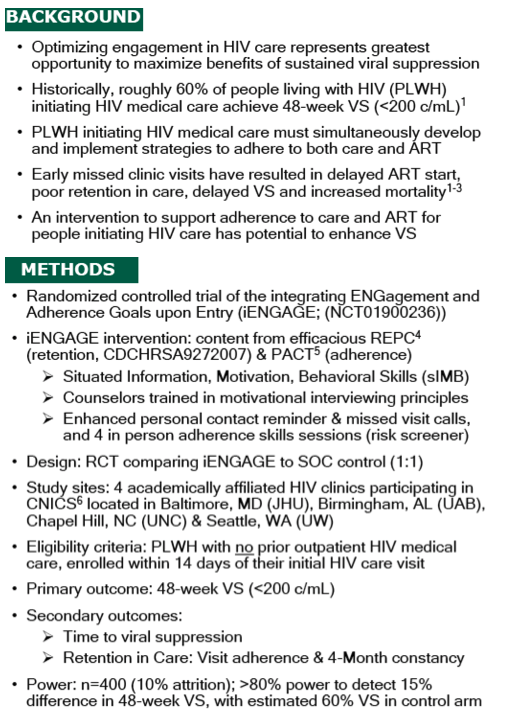
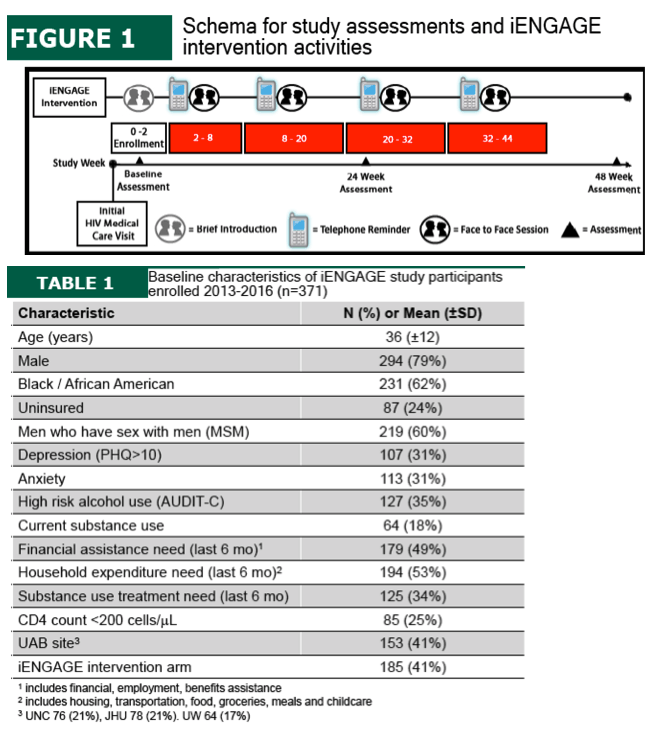
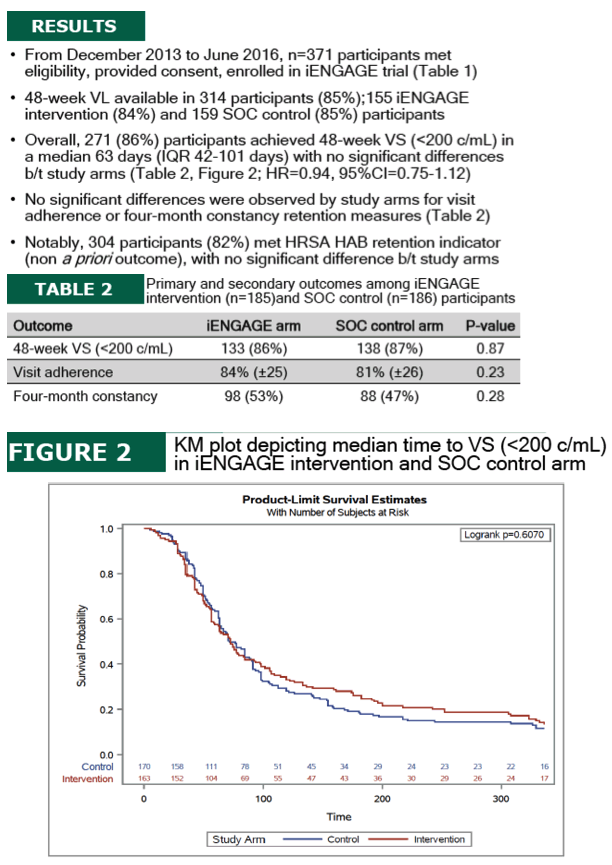
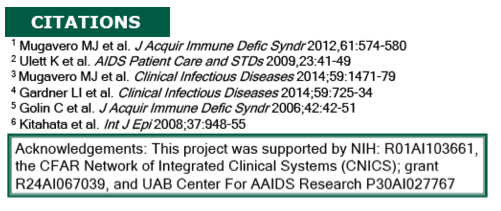
|
| |
|
 |
 |
|
|